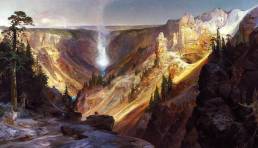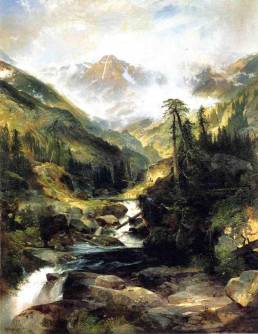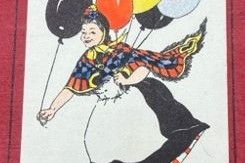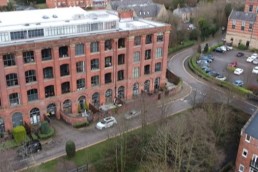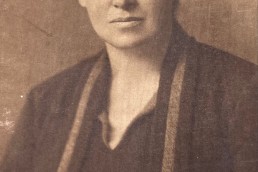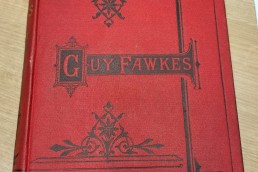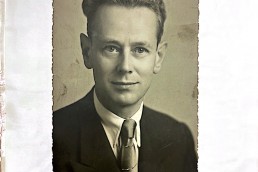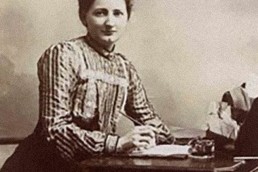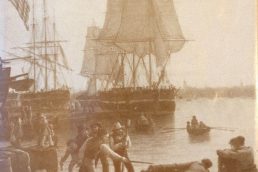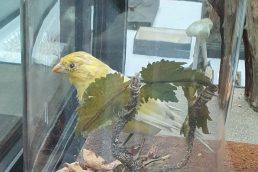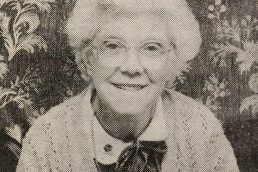This blog post examines the life and career of Thomas Moran, a Bolton-born English painter (1837-1926). The details provided below are informed by research located from various sources such as: Bolton Museum & Library Services; The National Gallery of Art (NGA); Tate Modern; thomas-moran.org, together with various other online sources (see bibliography, below).
Thomas Moran was born and raised to parents of handloom weavers on Back Balshaw street, Bolton, Lancashire, but when the rapid industrialisation of nineteenth-century England mechanicalized the weaving process, his parents were forced out of their jobs. The whole Moran family, therefore, emigrated to Kensington, just outside Philadelphia, in the United States of America. At the age of sixteen, Moran became an apprentice to a Philadelphia wood engraving firm, Scattergood & Telfer. It was there where Moran discovered his talent for painting and drawing. Working diligently, Thomas began to take his skill seriously, both as a watercolourist and an illustrator, and with the support of his brother, Edward Moran (who was also famous for his series of 13 historical paintings of United States marine history, which you can see, here), and an associate of the marine painter James Hamilton, Thomas’ passion as a budding artist grew.
In early 1860, Thomas Moran travelled to Lake Superior, the northern edge of Wisconsin, USA, where he painted and sketched the landscape of the Great Lakes. Back in Philadelphia, Moran sold lithographs of the Great Lakes before setting off to London to see the works of the famed British landscape and marine painter, JMW Turner. Moran’s work so impressed the director of the National Gallery, that Moran was given a private room to work in. As William H. Truettner explains in his essay ‘“Scenes of Majesty and Enduring Interest”: Thomas Moran Goes West’, upon returning to the U.S., Moran wanted to ‘go west’ and continue his paintings but had to wait for the right opportunity.
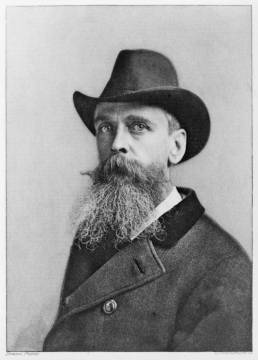

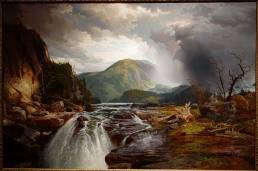

In early 1860, Thomas Moran travelled to Lake Superior, the northern edge of Wisconsin, USA, where he painted and sketched the landscape of the Great Lakes. Back in Philadelphia, Moran sold lithographs of the Great Lakes before setting off to London to see the works of the famed British landscape and marine painter, JMW Turner. Moran’s work so impressed the director of the National Gallery, that Moran was given a private room to work in. As William H. Truettner explains in his essay ‘“Scenes of Majesty and Enduring Interest”: Thomas Moran Goes West’, upon returning to the U.S., Moran wanted to ‘go west’ and continue his paintings but had to wait for the right opportunity.
That right opportunity came when a trip to Yellowstone in 1871 marked the turning point in Moran’s career. The previous year, Moran had been asked by Scribner’s Magazine to rework sketches made in Yellowstone by a member of an earlier expedition party. Intrigued by the geysers and mud-pots of Yellowstone, Moran borrowed money to make the trip himself. Numerous paintings and commissions resulted from this journey, but the sale of his enormous (7×12 feet) portrait of Grand Canyon of the Yellowstone, 1872, brought Moran considerable attention.
This painting depicts the canyon of the Yellowstone River’s lowest fall. Moran’s depiction of the Yellowstone region came to the attention of the U.S. Government and was considered among the most influential material brought before the United States congress. It hung in the in the United States’ capitol until 1950, when, by public law, it was transferred in perpetuity to the U.S. Department of the Interior.
That same year Moran travelled to Denver and then north to see the Mountain of the Holy Cross-a massive mountain with a cross of snow on its side. The resulting painting became Moran’s chief contribution to the Centennial Exposition in Philadelphia in 1876. Iconic in its union of wilderness and religion, The Mountain of the Holy Cross, became one of Moran’s best-known works. His reputation was established.
Moran continued to travel widely during the following decades. He returned to Europe several times again following trails blazed by Turner. In 1883 he journeyed to Mexico. In later years he returned to the Grand Canyon and travelled more extensively in Arizona and New Mexico, producing several striking works of the pueblos at Acoma and Laguna. Extraordinarily productive, both as a painter and an etcher, Moran continued to work well into his eighth decade. At his death in Santa Barbara, California, in August 1926, he was memorialized as the “Dean of American Landscape Painters.”
As a tribute to Thomas Moran, Bolton Museum and Library Service’s curator Matthew Watson, discusses one of Moran’s best-known works: Nearing Camp.
To discover the complete works of Thomas Moran, visit: www.thomas-moran.org
Bibliography
Anon. (2021) American Sublime: Room 8: The Great West. Tate Modern. [Online] Available at: <https://www.tate.org.uk/whats-on/tate-britain/exhibition/american-sublime/american-sublime-room-guide/american-sublime-6> [Accessed 16th April 2021].
Anon. (2021) Edward Moran. The Smithsonian American Art Museum. [Online] Available at: <americanart.si.edu/artist/edward-moran-3400> [Accessed 17th April 2021].
Anon. (2021) Teaching Guide, Hicks, The Peaceable Kingdom. Smart History. [Online] Available at: <https://smarthistory.org/geography-enviroment/tea> [Accessed 17th April 2021].
Anon. (2020) Thomas Moran and the Big Pictures. U.S. Department of the Interior. [Blog] 25 September 2020. Available at: <https://www.doi.gov/blog/thomas-moran-and-big-pictures> [Accessed 17th April 2021].
The Wild Lake Superior: Portrait of Thomas Moran’s: The Wild Lake Superior. [Online] Available at: <https://images.app.goo.gl/6FWmFRnPVDaKagJHA> [Accessed 17th April 2021]
The Complete Works of Thomas Moran. (2021). [Online] Available at: <www.thomas-moran.org> [Accessed16th April 2021].
Truettner, William H. (1976) ‘”Scenes of Majesty and Enduring Interest”: Thomas Moran Goes West’, The Art Bulletin 58(2), pp.241-259. [Online] Available at: <https://www.jstor.org/stable/3049500?socuuid=e99e6d8d-e1d3-44fd-b3b6-dc92d796df5c&socplat=email> [Accessed 16th April 2021].
Watson, M. (2020) ‘Looking Again at Nearing Camp with Matthew Watson’. Bolton Museum and Library Services. [Online video] Available at: <www.boltonlams.co.uk/artathome> [Accessed 16th April 2021].
Bibliography
Colby, Robert A. (1985) “Tale Bearing in the 1890s: The Author and Fiction Syndication”. Victorian Periodicals Review. Vol.18, No.1, pp. 2-16.
Hilliard, Christopher (2009) “The Provincial Press and the Imperial Traffic in Fiction, 1870s-1930s”. Journal of British Studies. Vol.48, No.3, pp. 653-673.
Johanningsmeier, Charles (1995) “Newspaper Syndicates of the Late Nineteenth Century: Overlooked Forces in the American Literary Marketplace”. Publishing History. Vol. 37, No.1, pp. 61-82.
Jones, Aled (1984) “Tillotson’s Fiction Bureau: The Manchester Manuscripts”. Victorian Periodicals Review. Vol.17, No.1, pp. 43-49.
Singleton, Frank (1950) Tillotson’s 1850-1950: Centenary of a Family Business. Bolton: Tillotson & Son Ltd.

